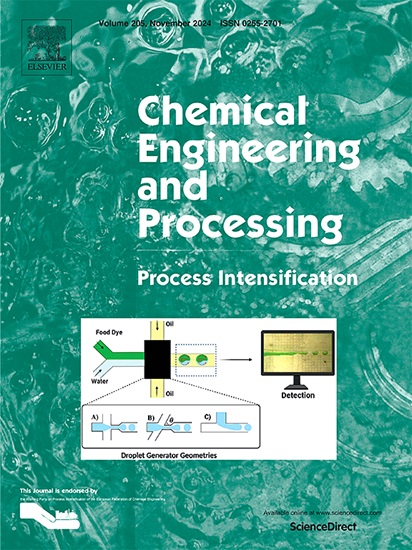Effect of ultrasonic pretreatment on methane production from peat
IF 3.8
3区 工程技术
Q3 ENERGY & FUELS
Chemical Engineering and Processing - Process Intensification
Pub Date : 2025-07-08
DOI:10.1016/j.cep.2025.110441
引用次数: 0
Abstract
This study investigated the effects of ultrasonic pretreatment on the chemical composition and biomethane production of herbaceous, woody, and mossy peats. The optimal conditions for ultrasonic pretreatment were established through single-factor and orthogonal experiments, utilizing reducing sugar yield as a key metric. Daily gas production, volatile fatty acids concentrations, pH levels, and reducing sugar yields during methane fermentation were measured to assess the effects of ultrasonic pretreatment on peat biomethanation. The optimal pretreatment conditions for mossy, herbaceous plants, and woody peat are 25 min, 35 min, and 2 min of ultrasonic treatment at 50 °C, 70 °C, and 60 °C, respectively. The solid-liquid ratios are 1:5, 1:3, and 1:3, respectively, and the particle sizes are 250 mesh, 250 mesh, and 40 mesh, respectively. After ultrasonic treatment, the contents of hemicellulose, and lignin decreased by 2.32 %, 1.77 %, respectively, in mossy peat; 1.00 %, and 2.70 %, respectively, in herbaceous peat; and 0.76 %, and 2.28 %, respectively, in woody peat. After ultrasonic treatment, the total biomethane production from mossy, herbaceous, and woody peats increased by 119.05 %, 84.69 %, and 13.55 %, respectively. Ultrasonic pretreatment enhances peat's biodegradability and biomethane production, thus being an effective strategy for increasing peat's biomethane yield.

超声波预处理对泥炭产甲烷的影响
研究了超声波预处理对草本、木质和苔藓泥炭化学成分和生物甲烷产量的影响。以还原糖得率为主要指标,通过单因素试验和正交试验确定了超声波预处理的最佳条件。测量了甲烷发酵过程中的日产气量、挥发性脂肪酸浓度、pH值和还原糖产量,以评估超声波预处理对泥炭生物甲烷化的影响。苔藓植物、草本植物和木质泥炭的最佳预处理条件分别为超声处理25 min、35 min和2 min,温度分别为50℃、70℃和60℃。料液比分别为1:5、1:3、1:3,粒径分别为250目、250目、40目。超声波处理后,苔藓泥炭中半纤维素和木质素的含量分别下降了2.32%、1.77%;在草本泥炭中分别为1.00%和2.70%;在木质泥炭中分别为0.76%和2.28%。超声波处理后,苔藓、草本和木本泥炭的总生物甲烷产量分别增加了119.05%、84.69%和13.55%。超声波预处理提高了泥炭的生物降解性和生物甲烷产量,是提高泥炭生物甲烷产量的有效策略。
本文章由计算机程序翻译,如有差异,请以英文原文为准。
求助全文
约1分钟内获得全文
求助全文
来源期刊
CiteScore
7.80
自引率
9.30%
发文量
408
审稿时长
49 days
期刊介绍:
Chemical Engineering and Processing: Process Intensification is intended for practicing researchers in industry and academia, working in the field of Process Engineering and related to the subject of Process Intensification.Articles published in the Journal demonstrate how novel discoveries, developments and theories in the field of Process Engineering and in particular Process Intensification may be used for analysis and design of innovative equipment and processing methods with substantially improved sustainability, efficiency and environmental performance.

 求助内容:
求助内容: 应助结果提醒方式:
应助结果提醒方式:


